GENGHIS KHAN'S CONQUESTS

The Mongols of Genghis Khan (Chinggis Khan, Chingiz Khan Jenghiz Khan) emerged in central Mongolia in the twelfth century under Genghis’s grandfather. Tribal alliances, wars, clan confederations, and more wars contributed to a new Mongol unity and organization and the eventual conquest of lands throughout Eurasia. At the time of his first kuriltai (Mongol council) at Karakorum in 1206 and the unification of "all the tribes living under felt-tents", Genghis already was engaged in a dispute with Western Xia, the first of his wars of conquest. In 1205 the Mongol military organization, based on the tumen , had defeated the much larger Tangut forces easily. Despite problems in conquering the well-fortified Western Xia cities, the results were the same in the campaigns of 1207 and 1209. When peace was concluded in 1209, the Western Xia emperor, with substantially reduced dominion, acknowledged Genghis as overlord. [Source: Robert L. Worden, Library of Congress, June 1989]
From 1207 to 1227, the Mongols under Genghis Khan were engaged in continuous wars. In what is now China, theye destroyed Xiliao, Hualazimo, and the Western Xia dynasty. He also defeated Jin's army and seized hold of its capital Zhong du. Much of northern China was conquered between 1211 to 1215, followed in 1220 to 1221 by the conquest of Persia. In 1223 a Mongol vanguard defeated a coalition of Russian princes on the Kalka River north of the Black Sea in present-day.Ukraine. A 13th-century Persian historian wrote of the Mongol campaigns: "With one stroke a world which billowed with fertility was laid desolate, and the regions thereof became a desert, and the greater part of the living, dead, and their skin and bones crumbling dust, and the mighty were humbled and immersed in the calamities of perdition."
In 1227, Genghis died of illness on the way to fighting against Western Xia dynasty, at the age of 66. Under Genghis's son and successor Ogadai the war in China was continued while Mongol armies invaded Hungary in 1241 to 1242 In China in 1266 he was given the posthumous title of "Shengwu Emporer". In 1309, he was again given the posthumous title of "Fatianqiyun Shengwu Emporer", and the posthumous title of honor of "Taizu". ~
Websites and Resources: Mongols and Horsemen of the Steppe: Wikipedia article Wikipedia ; The Mongol Empire web.archive.org/web ; The Mongols in World History afe.easia.columbia.edu/mongols ; William of Rubruck's Account of the Mongols washington.edu/silkroad/texts ; Mongol invasion of Rus (pictures) web.archive.org/web ; Encyclopædia Britannica article britannica.com ; Mongol Archives historyonthenet.com ; “The Horse, the Wheel and Language, How Bronze-Age Riders from the Eurasian Steppes shaped the Modern World", David W Anthony, 2007 archive.org/details/horsewheelandlanguage ; The Scythians - Silk Road Foundation silkroadfoundation.org ; Scythians iranicaonline.org ; Encyclopaedia Britannica article on the Huns britannica.com ; Wikipedia article on Eurasian nomads Wikipedia
Three Invasions Genghis Khan
According to Columbia University’s Asia for Educators: “Genghis Khan personally led three invasions. In each case, an economic issue was involved. 1) Tanguts: In 1209, Genghis set forth on a campaign against the Tanguts, who had established a Chinese-style dynasty known as the Xia, in Northwest China, along the old silk roads. The Tanguts had become involved in a trade dispute with the Mongols. Genghis quickly overwhelmed the Tanguts, received what he wanted in terms of a reduction of the tariffs the Tanguts imposed on trade, and returned to Mongolia. He did not capitalize upon his victory, this time, to expand the Mongols' territory. [Source: Asia for Educators, Columbia University afe.easia.columbia.edu/mongols ]
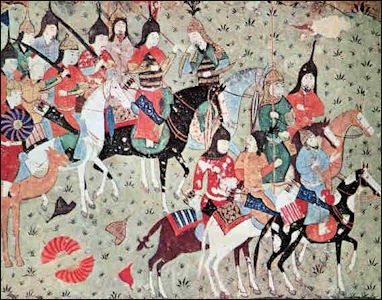
Genghis Khan during the Battle of the Indus
2) “Jin: The second campaign was against the Jin dynasty of North China, which controlled China down to the Yangtze River. The Jin were a people from Manchuria and were actually the ancestors of the Manchus. They too had become involved in a trade dispute with the Mongols, and the result was an attack by the Mongols, who desperately needed the products the Jin produced. By 1215, Genghis's troops had seized the area now known as Beijing and defeated the Jin, forcing them to move their capital south. Genghis had what he wanted in terms of additional trade — again, he returned to Mongolia.
3) “Central Asia: The third campaign was initiated because of the murder of envoys Genghis had sent to Central Asia. The shah of Central Asia, not knowing anything about Genghis or the Mongols, killed the envoys for being insolent enough to request changes in the conditions of trade between the Mongols and the Central Asians. From the Mongol standpoint, the murder of the ambassadors was the most heinous of crimes, and this campaign against Central Asia was first and foremost an act of revenge.
“After devoting considerable time to logistical planning, Genghis organized a major force and finally set forth against Central Asia in 1219. This would be the most devastating of his campaigns. Both sides engaged in mass slaughter, and it took several years for Genghis to successfully penetrate and conquer the great centers of Central Asia. And when he left Central Asia in 1225, Genghis didn't pull out all his forces as he had in his previous campaigns. This time, Genghis left behind Mongol troops to occupy the lands he had conquered. In 1227, still making his way back to Mongolia, Genghis Khan died.”
Genghis Khan's First Conquest

Mongols battling the Jin
Genghis Khan launched his first military campaign soon after being selected khan. In 1209, he easily captured Xi Xia, the capital of Tangust, a Tibetan-speaking kingdom of five million on China's northwest frontier. To reach Xi Xia (Western Xia), the Mongols had to cross the Gobi Desert, which they appeared to have trouble doing, and the major battle took place at a mountain pass where the Mongols feigned a retreat and then turned around and routed the enemy.
Xi Xia was made a Mongol vassal, which gave them control of a key Silk Road oasis and the tax revenues it brought in. The Xi Xia emperor Xiangzong gave Genghis Khan his daughter in marriage and offered tribute. Some 30,000 Xi Xia craftsmen were brought to Mongolia to help Genghis Khan build his capital of Karakorum.Genghis Khan "waged nearly continuous war against his neighbors." Explaining a rather gentle view of why Genghis Khan began conquering new lands outside of Mongolia, Mongolian historian Shirendev told National Geographic: "Once you are strong you want to go find out how other people live. He needed their knowledge to develop his country." When asked why his appetite for conquest seem insatiable, Shirendev quoted an old Mongolian proverb, "When you are eating, your appetite grows."
Other scholars have suggested he was motivated by revenge or the necessity of finding new pastures for his people. Columbia University historian Morris Rossabi told National Geographic: "I don’t think he consciously set out to be a conqueror. In general, he didn't try to hold on to territory, except for Mongolia."
Genghis Khan’s Early Wars in China
A major goal of Genghis was the conquest of Jin, both to avenge earlier defeats and to gain the riches of northern China. He declared war in 1211, and at first the pattern of operations against Jin was the same as it had been against Western Xia. The Mongols were victorious in the field, but they were frustrated in their efforts to take major cities. In his typically logical and determined fashion, Genghis and his highly developed staff studied the problems of the assault of fortifications. With the help of Chinese engineers, they gradually developed the techniques that eventually would make them the most accomplished and most successful besiegers in the history of warfare. [Source: Library of Congress, June 1989 *]
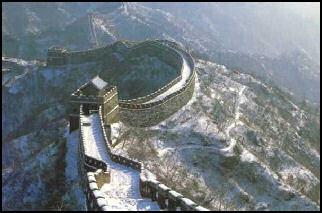 As a result of a number of overwhelming victories in the field and a few successes in the capture of fortifications deep within China, Genghis had conquered and had consolidated Jin territory as far south as the Great Wall by 1213. He then advanced with three armies into the heart of Jin territory, between the Great Wall and the Huang He. He defeated the Jin forces, devastated northern China, captured numerous cities, and in 1215 besieged, captured, and sacked the Jin capital of Yanjing (later known as Beijing). The Jin emperor did not surrender, however, but removed his capital to Kaifeng. There his successors finally were defeated, but not until 1234. Meanwhile, Kuchlug, the deposed khan of the Naiman Mongols, had fled west and had conquered the state of Karakitai, the western allies that had decided to side with Genghis.*
As a result of a number of overwhelming victories in the field and a few successes in the capture of fortifications deep within China, Genghis had conquered and had consolidated Jin territory as far south as the Great Wall by 1213. He then advanced with three armies into the heart of Jin territory, between the Great Wall and the Huang He. He defeated the Jin forces, devastated northern China, captured numerous cities, and in 1215 besieged, captured, and sacked the Jin capital of Yanjing (later known as Beijing). The Jin emperor did not surrender, however, but removed his capital to Kaifeng. There his successors finally were defeated, but not until 1234. Meanwhile, Kuchlug, the deposed khan of the Naiman Mongols, had fled west and had conquered the state of Karakitai, the western allies that had decided to side with Genghis.*
By this time, the Mongol army was exhausted by ten years of continuous campaigning against Western Xia and Jin. Therefore, Genghis sent only two tumen under a brilliant young general, Jebe, against Kuchlug. An internal revolt was incited by Mongol agents; then Jebe overran the country. Kuchlug's forces were defeated west of Kashgar; he was captured and executed, and Karakitai was annexed. By 1218 the Mongol state extended as far west as Lake Balkash and adjoined Khwarizm, a Muslim state that reached to the Caspian Sea in the west and to the Persian Gulf and the Arabian Sea in the south.*
Genghis Khan Invades Northern China
When he Mongols invaded Jin it was a rich empire in northern China with 20 million people. From intelligence sources such as merchants and defecting Jin civil servants, Genghis Khan learned that Jin empire was racked with internal problems and vulnerable to attack and that its huge army of 600,000 troops was pinned down on the southern border where the Jinns were engaged in a long-running war with the Chinese.
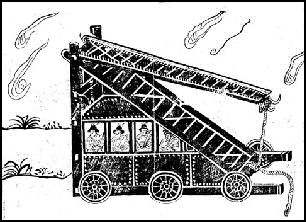
Cloud ladder, a wall-mounting devise Before leaving on the 1211 campaign against the Jin with a force of 70,000 men, Genghis Khan told his people that "Heaven has promised me victory." The Mongols breached what would become the Great Wall of China by advancing through a 15-mile-long gorge with the help of a turncoat Chinese general.The Mongols had little trouble conquering the overmanned and inefficient Jin army. Using the feigned retreat tactic once again to great success, a Mongol general nicknamed "Arrow" defeated the Jin army at an important battle at Juyong Pass. Capturing the Jin capital of Zhongdu (near present-day Beijing) was more problematic. The 40-foot walls that surrounded the city of initially proved to be too difficult to surmount as the Mongol army contented itself with pillages the Jin subjects in countryside around Zhongdu.
In 1214, the Mongols surrounded Zhongdu and used catapults to bombard the city's walls. After a short siege, the Jin Emperor Xuanzong gave up and offered Genghis Khan gold, silver, other treasures and a Jin princess with 500 servants if the Mongol leader would called off his attack.
Fearing another Mongol offensive, the Jin emperor moved his capital from Zhonghu southward to Kaifeng in 1214. Suspecting that the Jin emperor might be trying to regroup for an attack, the Mongols laid siege to Zhongdu again and this time pulverized the city and made off with the imperial treasure. Years later when a traveler remarked about a white hill he was told it was from the bones of Zhongdu's victims.
Genghis Khan Looks Westward
The war in China continued under the leadership of one the Khan's general while Genghis Khan advanced to the west. The Mongol leader didn’t seem interested in including Jin in his empire, only extracting tribute from it. The Jin were finally overthrown by the Mongols in 1235 two years after Kaifeng was captured.
In 1218, Genghis Khan attention was drawn to Kara-Khitai, a small, rival Mongol state run by a prince from the Naiman tribe, a group that Genghis had defeated in Mongolia. The Mongol general Jebe attacked the Kara-Khitai capital with 20,000 horseman, the prince was captured and beheaded, and kingdom was annexed by the Mongols.
By this time Genghis Khan reputation had spread. To make sure they were not next on the list of conquests, envoys from Korea arrived at Genghis Khan's ger, offering to pay tribute.

Genghis Khan in Khwarizm (Central Asia)
In 1218 the governor of an eastern province of Khwarizm mistreated several Mongol emissaries. Genghis retaliated with a force of more than 200,000 troops, and Khwarizm was eradicated by 1220. A detachment of about 25,000 Mongol cavalry, as part of the Khwarizmian campaign, had crossed the Caucasus Mountains, had skirted the Caspian Sea, and had briefly invaded Europe. [Source: Library of Congress, June 1989 *]
In 1218, a caravan of Mongol merchants was sent by Genghis Khan to Khwarizm, a Muslim empire that stretched to the Caspian Sea and included parts of present-day Afghanistan and Iran. The merchants were sent to give the shah of Khwarizm gifts of jade, ivory, gold and cloaks of valuable white camel hair.
Suspecting that were spies, a Khwarizm governor ordered the merchants killed. An ambassador sent by Genghis Khan to the Khwarizm shah was also killed. The great khan was pissed, and he vented his fury with a string of massacres against Muslim kingdoms beginning with Utrar and Bukhara in 1219.
Before the murder of the merchants, Genghis Khan had been fairly calculating in his conquests. The killings turned him into a kind psychopath bent on revenge. The killing of the ambassador was a particular heinous crime one historian said because the "Mongols believed in the absolute inviolability of ambassadors."
By the time the Mongols were through in Central Asia maybe 30 percent of the population there was massacred. To this day the agriculture and irrigation systems have not been repaired in some devastated areas.
Genghis Khan Attacks Bukhara
In 1219, a Mongol force of 110,000 was divided into columns for an assault on the cities of Bukhara and Utrar, where the Khwarizm shah's army of 400,000 men where holed up. Although probably outnumbered, the Mongols captured the cities after a month-long siege. One witness who escaped wrote, "They came, they raped, they burnt, they slew, they plundered and they departed."
In Utrar, the governor who had ordered the death of the Mongol merchants, was captured and subject to a horrible death in presence of Genghis Khan. Many more were killed. Juini wrote: "in retribution for every hair on their heads it seemed that a hundred thousand heads rolled in the dust."
To reach Bukhara, Genghis Khan is credited with crossing the fierce 300-mile-wide Kyzl Kum desert but most likely he prudently followed a road that skirted the "uncrossable" wasteland. In Bukhara, Genghis Khan entered a mosque and reportedly emptied cases that contained the Koran, the Muslim's holiest book, and had them filled with grain for his horses. Upon leaving the mosque he declared, "I am the punishment of God. If you had not committed great sins, God would not have sent a punishment like me on you."
Genghis Khan ordered the rulers of Bukhara to bring some musicians, wine and fermented mare's milk, then commanded the nobility to bring their riches, gold and precious stones and lay them at his feet. Only then were his troops set loose. They took everything. The mosque was burned. The fire probably spread and left the city in ruins.

Alal al-Din Khwarazm-Shah crossing the Indus river, escaping Chinggis Khan
A group of about a thousand soldiers did not want to surrender. They took refuge in the mosque, where they thought Allah would protect them. They also reasoned the Mongols wouldn't dare kill them there. But they were wrong. For the Mongols there was no difference between a mosque and a battlefield. The Mongols shot flaming arrows in the mosque and may have hurled burning oil with catapults.
By the time the Mongols were finished, Samarkand's wall had been torn down, the aqueduct was in ruins, and an estimated 100,000 people were killed. Around 30,000 skilled men including smiths, weavers, artisans, falconers, scribes and physicians were taken back to Mongolia.
Attack of Samarkand
In 1220, Genghis Khan attacked Samarkand, then a great silk road city of 200,000 people, nourished by an aqueduct that brought water to the arid steppe around the city from far away mountains, and famous for its craftsmen that produced saddles, copper lamps and silver lamé.
Samarkand was the capital of the Khwarizm empire and the home of Khwarizm shah. When Genghis Khan's army appeared, according to one report, the shah and 110,000 of his troops fled the city and the city noblemen opened the gates begging for mercy.
Mongol Attacks After Samarkand
Genghis Khan's armies then destroyed other great Silk Road trading centers such as Urgench (Uzbekistan), Merv (Turkmenistan), Balkh (Afghanistan), Nishapur (Iran), Ghazni (Afghanistan), and Herat (Afghanistan).
Kingdoms that resisted risked having their entire populations massacred. According to Muslim chroniclers, 100,000 defenders were killed and a river was diverted to flood the city of Urgench near the Aral Sea.
In Merv in present-day Turkmenistan, a Muslim holy men and his helpers spent 13 days counting 1.3 million victims "taking into account only those that were explain to see. Under the Seljuk Turks, Merv had become a city full of palaces, libraries, observatories, and canals that nourished parks and lush gardens. All this came to an end when messengers of Genghis Khan in 1218 appeared, demanding tribute and the pick of the city’s most beautiful women. The Seljuks refused and killed the messengers. The Mongol arrived three years later and demanded that city surrender. The Seljuks complied and the Mongols responded by massacring all the city’s inhabitants. According to some accounts each Mongol soldiers was ordered to decapitate 300 to 400 civilians and set the city aflame. After the Mongols left, Merv remained uninhabited for more than a century.
Most historians believe the huge casualties figures were greatly exaggerated. These cities as important as they were didn't have that many people and there was little incentive to slaughter that many people. "I can't believe they would have wasted time doing that," historian Larry Moses said. "The Mongols pretty much annihilated the armies they came against and a lot of civilians were marched in front of the army as cannon fodder, but I don't think a lot of citizens were wiped out. The Mongols needed people to move their packtrains and siege weapons."
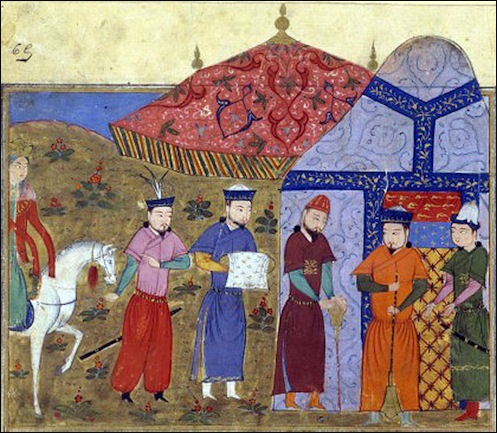
Kingdoms that resisted risked having their entire populations massacred. Those that surrendered and offered a tribute were spared. The Mongols typically captured a city, killed as many of the people, saved the craftsmen and sent them to their cites, and spared some local officials to help them run the city.
Mongols in Afghanistan
Genghis Khan's armies then destroyed other great Silk Road trading centers of Balkh, Nishapur, Ghazni and Herat, all in present-day Afghanistan and Iran. Damage done to the irrigation systems there have never been repaired.
The Mongol arrived in Herat, Afghanistan in 1221 and captured the city. The inhabitants were initially spared. But when they rose in revolt Genghis Khan told one his generals, "Since the dead have come to life, I command you to strike their heads from their body." Reportedly only 40 of the city’s inhabitants survived.
By one estimate 1.6 million people were killed at Herat (no doubt an exaggeration, a more likely figure is 160,000). The inhabitants were initially spared after Herat was captured in 1221, but when they rose in revolt Genghis Khan told one his generals, "Since the dead have come to life, I command you to strike their heads from their body." Reportedly only nine people survived.
In Nishapur 1.7 million are said to have been killed (again an exaggeration, but there may have been as many as 500,000 people there). By some accounts when the Mongols had finished in 1219 no one was left. In Balkh, Afghanistan, the citizens of this fabled "Mother of Cities" were massacred after surrendering — "divided up according to the usual custom of hundreds and thousands put to the sword."
After conquering the cities of the Khwarizm, Genghis Khan headed south and spent of 1221-22 in the Hindu Kush in Afghanistan. His generals Subedei and Jebe circled the Caspian Sea in 1221-23 with 20,000 men and annihilated every army that got in their way.
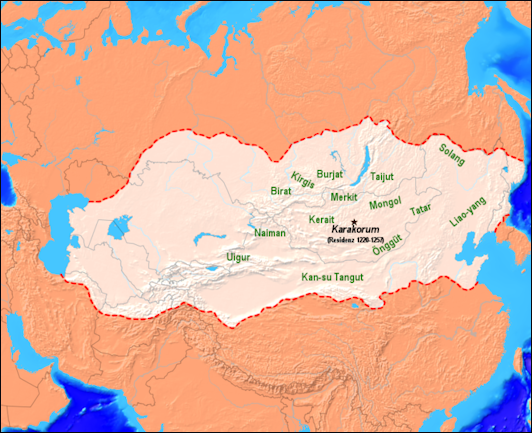
Empire of Genghis Khan at his death
Mongols Reach Russia and Europe
Subedei and Jebe defeated two large armies in Georgia, crossed the Caucasus Mountains in winter and defeated an 80,000-man Russian army led by Princes from the not-yet-united principalities of Kiev, Chernigov, Galicia, Rostov and Suzdal at the Klaka River in 1223.
After defeating the Georgians and the Cumans of the Caucasus, the small Mongol expedition advanced in 1222 into the steppes of the Kuban. Combining rapid movement with guile, the Mongols again defeated the Cumans, captured Astrakhan, then crossed the Don River into Russia. Penetrating the Crimea, they stormed the Genoese fortress of Sudak on the southeastern coast, then turned north into what later became known as the Ukraine. [Source: Library of Congress, June 1989 *]
The Mongol leaders now thought they had accomplished their mission. Before returning to Mongolia, however, they decided to rest their troops and to gain more information about the lands to the north and the west. They camped near the mouth of the Dnieper River, and their spies soon were scattered throughout eastern and central Europe.*
Meanwhile, a mixed Russian-Cuman army of 80,000 under the leadership of Mstislav, prince of Kiev, marched against the Mongol encampment. Jebe and Subetei, another great Mongol general, sought peace; however, when their envoys were murdered, they attacked and routed Mstislav's force on the banks of the Halha River. Historian Charles Halperin estimated that by this time the "destructive power of the Mongol war machine eclipsed anything the Russians had seen before," and the Kievan Russians found themeselves faced no longer with a renewal of the sporadic raids of the past but with the threat of subjugation and foreign domination. In compliance with a courier message from Genghis, the expedition then marched eastward. As the Mongols were marching north of the Caspian Sea, Jebe died of illness. In 1224 Subetei led the expedition back, after a trek of more than 6,400 kilometers, to a rendezvous with the main Mongol armies, that were returning from their victories over the Khwarizm.*
The Mongols defeated the Russians by attacking first with lightly-armored archers and luring the enemy behind a smoke screen set by dung fires. Then cavalry men armed with lances and swords charged, forcing the Russia force to break ranks and run over each other as fled for their lives. After the victory Subedei and Jebe dined on top of a box inside which three captured Russian princes were suffocated to death. Subedei and Jebe's army had traveled some 8,000 miles in "one of the greatest cavalry exploits of all time," living off the land and acquiring fresh horses by conquest. The conquering Mongol armies met in 1224 near the Irtysh River in southern Russia.
Counterattacks Against the Mongols in Central Asia

Portrait of Genghis Khan
The vassal emperor of Western Xia had refused to take part in the war against the Khwarizm, and Genghis had vowed punishment. While he was in Iran, Western Xia and Jin had formed an alliance against the Mongols. After rest and a reorganization of his armies, Genghis prepared for war against his foes. [Source: Library of Congress, June 1989 *]
Muslim forces lead by Shah Muhammad's son Jalal ad-Din failed in their attempt to retake Kharizam in 1223 but they did defeat the Mongols in one battle: courageously charging the Mongol army when they were pinned against the Indus River. Genghis Khan admired Jalal ad-Din's bravery. When the Muslims jumped into the river to escape capture, Genghis forbade his archers to shoot them down, saying, "Such a son must a father have!" As for Muhammad he was chased by the Mongol general Jebe across Central Asia to Iran, where he died of pleurisy and was buried as a peasant.
After seizing all of western Turkestan, Genghis Khan returned to the kingdom of Xi Xia near Tibet to mete out Mongol justice to the king who refused to supply troops for the Mongol campaign in the west. After the Mongols finally captured the city of Tangut in a brutal, hard-fought battle, the Tangus rulers and most of the citizens are killed. Khan reportedly ordered the extermination of the Xi Xia people and his army reportedly killed "mothers and fathers down to the offspring for their offspring." So complete was the defeat that for all intents and purposes Xi Xia disappears from history.
Last Campaign of Genghis Khan
By the time of the counterattacks against the Mongols in Central Asia, advancing years had led Genghis to prepare for the future and to assure an orderly succession among his descendants. He selected his son Ogedei as his successor and established the method of selection of subsequent khans, specifying that they should come from his direct descendants. Meanwhile, he studied intelligence reports from Western Xia and Jin and readied a force of 180,000 troops for a new campaign. [Source: Library of Congress, June 1989 *]

hillside portrait in Mongolia
Late in 1226, when the rivers were frozen, the Mongols struck southward with their customary speed and vigor. The Tangut, well acquainted with Mongol methods, were ready, and the two armies met by the banks of the frozen Huang He. Despite a Western Xia army of more than 300,000 troops, the Mongols virtually annihilated the Tangut host.*
Pursuing energetically, the Mongols killed the Western Xia emperor in a mountain fortress. His son took refuge in the great walled city of Ningxia, which the Mongols had failed to conquer in earlier wars. Leaving one-third of his army to take Ningxia, Genghis sent Ogedei eastward, across the great bend of the Huang He, to drive the Jin forces from their last footholds north of the river. With the remainder of his troops, he marched southeast, evidently to eastern Sichuan Province, where the Western Xia, the Jin, and the Song empires met, to prevent Song reinforcements from reaching Ningxia. Here he accepted the surrender of the new Western Xia emperor but rejected peace overtures from Jin.*
A premonition of death caused Genghis to head back to Mongolia, but he died en route. On his deathbed in 1227, he outlined to his youngest son, Tului, the plans that later would be used by his successors to complete the destruction of the Jin empire.
Image Sources: Wikimedia Commons
Text Sources: Mike Edwards, National Geographic: Genghis Khan: December, 1996; After Genghis Khan: February 1997; National Geographic, New York Times, Washington Post, Los Angeles Times, Times of London, Smithsonian magazine, The New Yorker, Reuters, AP, AFP, Wikipedia, BBC, Comptom’s Encyclopedia, Lonely Planet Guides, Silk Road Foundation, “The Discoverers “ by Daniel Boorstin; “ History of Arab People “ by Albert Hourani (Faber and Faber, 1991); “Islam, a Short History “ by Karen Armstrong (Modern Library, 2000); and various books and other publications.
Last updated October 2022
